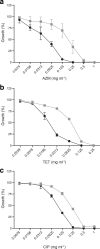Azithromycin resistance mutations in Streptococcus pneumoniae as revealed by a chemogenomic screen
- PMID: 33074087
- PMCID: PMC7725334
- DOI: 10.1099/mgen.0.000454
Azithromycin resistance mutations in Streptococcus pneumoniae as revealed by a chemogenomic screen
Abstract
We report on the combination of chemical mutagenesis, azithromycin selection and next-generation sequencing (Mut-Seq) for the identification of small nucleotide variants that decrease the susceptibility of Streptococcus pneumoniae to the macrolide antibiotic azithromycin. Mutations in the 23S ribosomal RNA or in ribosomal proteins can confer resistance to macrolides and these were detected by Mut-Seq. By concentrating on recurrent variants, we could associate mutations in genes implicated in the metabolism of glutamine with decreased azithromycin susceptibility among S. pneumoniae mutants. Glutamine synthetase catalyses the transformation of glutamate and ammonium into glutamine and its chemical inhibition is shown to sensitize S. pneumoniae to antibiotics. A mutation affecting the ribosomal-binding site of a putative ribonuclease J2 is also shown to confer low-level resistance. Mut-Seq has the potential to reveal chromosomal changes enabling high resistance as well as novel events conferring more subtle phenotypes.
Keywords: Azithromycin; Glutamine; Resistance; Streptococcus pneumoniae; chemical mutagenesis; macrolide; next generation sequencing.
Conflict of interest statement
The authors declare that there are no conflicts of interest.
Figures



Similar articles
-
Azithromycin treatment failure in community-acquired pneumonia caused by Streptococcus pneumoniae resistant to macrolides by a 23S rRNA mutation.Diagn Microbiol Infect Dis. 2002 Jun;43(2):163-5. doi: 10.1016/s0732-8893(02)00379-6. Diagn Microbiol Infect Dis. 2002. PMID: 12088625
-
Mutations in 23S rRNA and ribosomal protein L4 account for resistance in pneumococcal strains selected in vitro by macrolide passage.Antimicrob Agents Chemother. 2000 Aug;44(8):2118-25. doi: 10.1128/AAC.44.8.2118-2125.2000. Antimicrob Agents Chemother. 2000. PMID: 10898684 Free PMC article.
-
Ribosomal Mutations Conferring Macrolide Resistance in Legionella pneumophila.Antimicrob Agents Chemother. 2017 Feb 23;61(3):e02188-16. doi: 10.1128/AAC.02188-16. Print 2017 Mar. Antimicrob Agents Chemother. 2017. PMID: 28069647 Free PMC article.
-
Macrolide Resistance in Streptococcus pneumoniae.Front Cell Infect Microbiol. 2016 Sep 21;6:98. doi: 10.3389/fcimb.2016.00098. eCollection 2016. Front Cell Infect Microbiol. 2016. PMID: 27709102 Free PMC article. Review.
-
Macrolide and ketolide resistance with Streptococcus pneumoniae.Med Clin North Am. 2006 Nov;90(6):1109-24. doi: 10.1016/j.mcna.2006.07.010. Med Clin North Am. 2006. PMID: 17116439 Review.
Cited by
-
Amino Acid Starvation-Induced Glutamine Accumulation Enhances Pneumococcal Survival.mSphere. 2023 Jun 22;8(3):e0062522. doi: 10.1128/msphere.00625-22. Epub 2023 Apr 5. mSphere. 2023. PMID: 37017541 Free PMC article.
-
Mechanism of action, resistance, synergism, and clinical implications of azithromycin.J Clin Lab Anal. 2022 Jun;36(6):e24427. doi: 10.1002/jcla.24427. Epub 2022 Apr 21. J Clin Lab Anal. 2022. PMID: 35447019 Free PMC article. Review.
-
New Resistance Mutations Linked to Decreased Susceptibility to Solithromycin in Streptococcus pneumoniae Revealed by Chemogenomic Screens.Antimicrob Agents Chemother. 2023 Aug 17;67(8):e0039523. doi: 10.1128/aac.00395-23. Epub 2023 Jul 6. Antimicrob Agents Chemother. 2023. PMID: 37409958 Free PMC article.
References
-
- Sader HS, Mendes RE, Le J, Denys G, Flamm RK, et al. Antimicrobial susceptibility of Streptococcus pneumoniae from North America, Europe, Latin America, and the Asia-Pacific region: results from 20 years of the SENTRY antimicrobial surveillance program (1997–2016) Open Forum Infect Dis. 2019;6:S14–S23. doi: 10.1093/ofid/ofy263. - DOI - PMC - PubMed
-
- Schroeder MR, Chancey ST, Thomas S, Kuo W-H, Satola SW, et al. A population-based assessment of the impact of 7- and 13-Valent pneumococcal conjugate vaccines on macrolide-resistant invasive pneumococcal disease: emergence and decline of Streptococcus pneumoniae serotype 19A (CC320) with dual macrolide resistance mechanisms. Clin Infect Dis. 2017;65:990–998. doi: 10.1093/cid/cix446. - DOI - PMC - PubMed
Publication types
MeSH terms
Substances
Grants and funding
LinkOut - more resources
Full Text Sources
Medical

